Hosta Blue Angel - variety description
An ornamental plant of the Asparagus family - Hosta Blue Angel was bred by the Dutch breeder Aul Aden in 1986 on the basis of two varieties - aden 365 and aden 361. It gained the greatest popularity in Japan and is considered a sacred flower. Consider the main description, as well as the rules of planting and care.
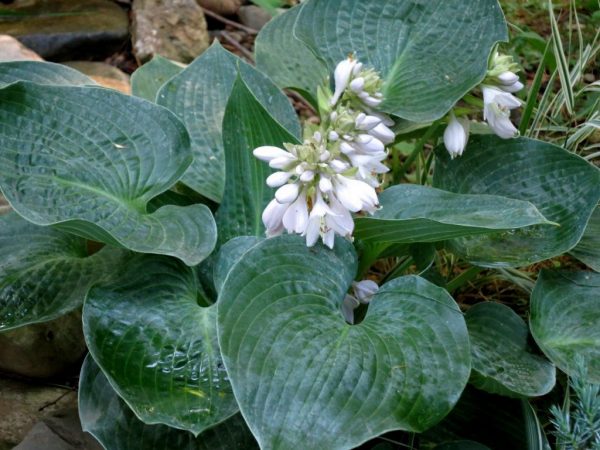
Hosta angel
general characteristics
The name in Latin is hosta blue angel, which translates as "Blue Angel".
This variety is intended for cultivation in the middle lane, because has a weak resistance to frost.
Khosta has an intensive growth - it grows up to 10 cm per season. Flowering is long - it begins at the end of July and ends in the last days of August or in the first decade of September.
External description:
- large-leaved shrub with a domed crown;
- leaflets develop on rigid, elongated petioles;
- the size of the leaf plate is 40x30 cm, the color is blue-green, parallel light streaks are clearly visible on the slightly corrugated surface;
- the height is 70-80 cm, but under conditions of good care and maintenance, the bush can reach 90-100 cm, and its circumference is 120 cm;
- after 2-3 years of development, long, rigid peduncles appear on which hyacinth-like flowers are located, collected in racemose cone-shaped inflorescences;
- the color of the petals is different - from snow-white to lavender;
- after the flowers dry up, fruits are formed in the form of leathery brown bolls with black seeds 3 mm long.
Landing features
The success of perennial cultivation depends on several factors - the quality of the planting material, the location and composition of the soil.
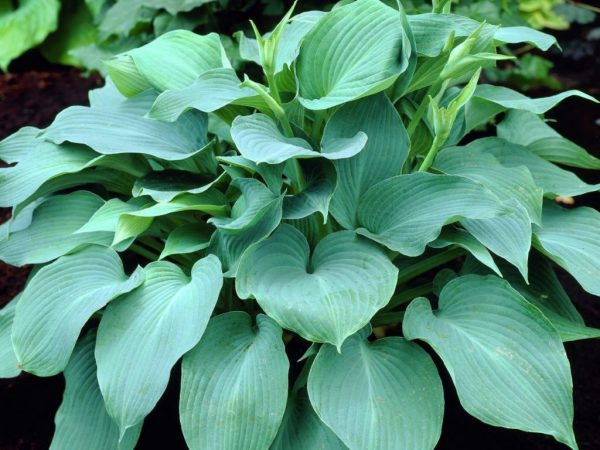
Hosta blue angel
Timing
The best time for planting seedlings is from mid-April to the second decade of May, when the ground warms up well and the threat of return frosts is over. So you eliminate the risk of freezing of the delicate and not yet matured root system of young plants.
Place and soil
In the wild, the bush grows in shady forests, near lakes, on moist soil. He needs to provide the same conditions in the garden.
It is better to plant under tall trees, shrubs, near a fence or a gazebo, where in the afternoon there is full shade. In the sun, its delicate foliage will quickly fade and turn yellow.
Grows well on loose, drained soil with a high humus content. It is important that the acidity level is neutral. Therefore, if necessary, the soil is deoxidized with chalk, slaked lime or dolomite flour - 350 g per 1 m².
If the ground is knocked down and heavy, it is necessary to improve its structure with sand, perlite or vermiculite - 2 buckets per 1 m².
Before planting, the site is freed from garden debris, dug deeply and leveled.
Seedling preparation
You can buy planting material at a gardening store. Choose seedlings with unopened buds - they take root better after transplanting than plants with foliage.It is important that they are juicy, fresh without yellowness, black spots and dried out fragments.
Buy hosts with earthen clods or planted in containers - they quickly adapt after planting in the garden. In addition, the root system is protected from drying out until it is planted in open ground.
The pot is crumpled to facilitate the extraction of the roots, then the rhizome is dipped in cold water for an hour. The longest roots are pruned 2-3 cm in order to stimulate the further development of new shoots.
Landing technique
Pits are dug at a distance of 1.5-2 m so that the bushes can fully develop without competition for moisture and space.
Their depth and width should be twice as large as the roots. Each hole is filled with a nutrient composition for a third of its volume - peat and leaf compost are mixed in equal amounts. It is poured with a mound, the root system is installed on top, straightened, covered with the remaining fertile soil, trampled, watered. 5 liters of water are poured under one bush.
At the end, add mulch to prevent rapid evaporation of moisture. Use shredded bark or peat.
When planting, it is important that the buds are at the level of the ground; when they are buried, there is a high risk of decay and death of the entire bush.
In the first two weeks, unstable seedlings are very sensitive to sunlight, so at noon they are shaded with burlap or agrofibre.
Care rules
Watering
For 3 weeks, young plantings are watered every other day to help them take root and grow faster.
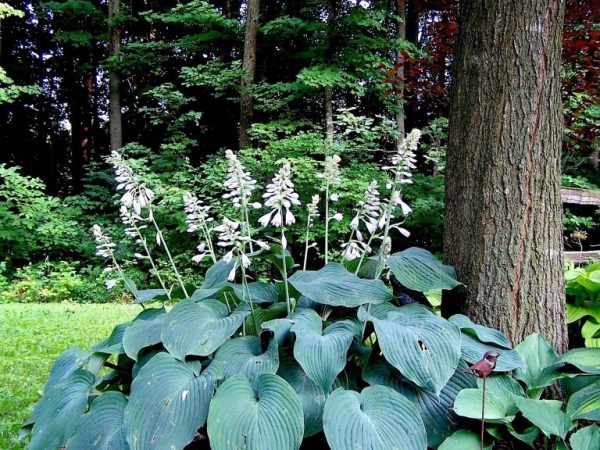
Hosta blue angel
Given that this is a moisture-loving culture, from spring to autumn it is moistened twice a week, provided that the summer is dry.
On hot days, the hostu is sprinkled with warm water to maintain its decorative qualities and to avoid wilting. The procedure is carried out in the evening when the sun goes down.
The soil around the bushes is regularly loosened so that it allows moisture and oxygen to pass through well. At the same time, weeds are removed, the aisles are weeded, and mulch (peat or leaf compost) is added, which protects the soil from rapid drying out.
Top dressing
The blue angel host does not need to be fed, but regular feeding will increase its decorative qualities and stimulate rapid growth. Fertilizers can be applied 3-4 times per season:
- in early spring, the land is enriched with liquid nitrogen preparations - a solution of bird droppings (1:20), slurry (1:10);
- before and after flowering, they are fed with a mixture of superphosphate and potassium sulfate - 15 g per bucket of water;
- in the fall, rotted manure or leaf compost is placed in the trunk circle.
Pruning
The host does not need to be configured, because initially develops a beautiful, compact crown. Throughout the entire period of growth and development, only non-viable parts are removed that have withered, turned yellow, rotted or have been damaged by diseases.
Preparing for winter
When grown in the southern zone and in regions with a temperate climate, the culture does not need insulation, the only thing that can be done is to spud the near-trunk zone with straw, peat or sawdust.
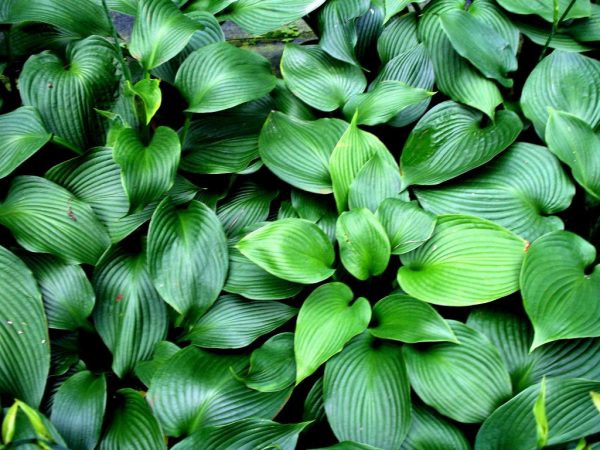
Hosta blue angel photo
If the hosta grows in harsh climatic conditions, in addition to mulching, it is necessary to cover the aboveground part with spruce branches or burlap.
Reproduction
There are three ways to reproduce this decorative deciduous perennial.
By dividing the rhizome
The procedure begins in late spring or early autumn. The plant is watered abundantly, dug out, washed the roots from the remnants of the earth, dried. Divided into several parts with roots and at least one growth point. Places of cuts are disinfected with charcoal, seated separately.
Cuttings
This method consists in separating cuttings with part of the root without digging out the bush. Use strong, healthy shoots, dip them in Kornevin's solution. Then they are planted in the open field in a mixture of peat and sand. The seedlings are shaded from the sun, irrigated regularly with warm water.As soon as they release new leaves (after about 1-1.5 months), they can be planted according to the same scheme and principle as purchased plants.
Seeds
This method is considered laborious and not always justified, since the seeds have poor germination (70-80%). To increase this indicator, the purchased seed is treated with one of the growth stimulants (Epin or Zircon) or kept in the refrigerator for a month.
The seedling box and soil mixture (peat soil, leaf compost and sand, mixed in equal amounts) are sterilized - spilled with boiling water or a strong solution of potassium permanganate.
Sowing of seeds is started at the end of April or at the beginning of May. A thin layer of expanded clay is poured onto the bottom of the container with drainage holes, then filled with a mixture of humus, peat and coarse sand (1: 1: 1), moistened. Seeds are laid out on the surface, sprinkled with soil mixture (5-7 mm). Slightly crushed, covered with transparent glass or film and placed in a shaded place. The optimum temperature for seedling germination is 22-25 ° C.
After about 2-3 weeks, shoots will appear, then the shelter is removed. At the stage of development of one pair of leaves, the sprouts dive into separate pots. Transplanted to the site after a month of home growing.
Diseases and pests
The Blue Angel hosts have several diseases and pests that appear when planting and care conditions are violated.
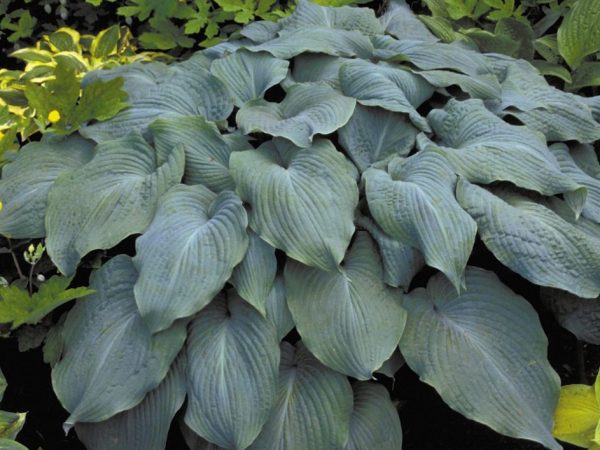
Hosta blue angel description and photo
Phylostictosis. Signs - the foliage is covered with brownish-yellow shapeless spots. It is not subject to treatment, so the bush is dug up, burned, the place of growth is spilled with a fungicide.
Gray rot. It manifests itself in the form of dark brown spots with a grayish bloom on the surface of the leaves. All affected parts are cut out, the crown is treated with an Azocene solution or other fungicide.
Rot of the root collar. The main reason is too deep planting of seedlings and overmoistening with cold water. At an advanced stage, it is difficult to cure the disease, so the host is dug up and disposed of. At the beginning of the lesion, the plant needs to be watered, dug out, cut out rotten parts to healthy tissue, treated with a solution of copper sulfate, dried and transplanted to a new place.
Viruses (X, HVX). Symptoms - the foliage is covered with small black and yellow round spots. Over time, the virus covers the entire leaf, the edges curl, the tissues die off. The bush stops growing and gradually withers away. The host is dug up and disposed of along with the soil, where it grows.
Slugs. They feed on foliage, gnaw out the tissues at the bottom of the bush, and later move to the upper part. To get rid of pests, it is necessary to sprinkle the Thunderstorm granular bait or aldehyde in the near-trunk zone. In the evening, put sheets of plywood under the bushes, and in the morning, collect and destroy the insects that have accumulated on it.
Leaf nematode. It parasitizes the tissues of the leaves, leaves brown stripes (passages) on their surface. It is difficult to get rid of the insect, so the host is disposed of, and the soil is spilled with a fungicide.
Application in landscape design
The Blue Angel variety is used in single and group plantings in combination with other hosta varieties, mosses, heather, undersized decorative flowering plants.
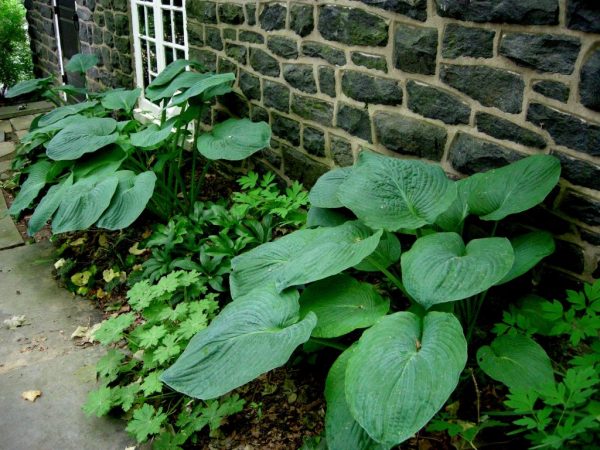
Hosta blue angel photo:
Also, the plant is used in the design of flower beds, mixborders, ridges, rock gardens and rockeries, planted along ponds, fences, curbs and on alleys.
Testimonials
According to numerous reviews of the host, blue angel is one of the most valuable and unpretentious varieties in the content:
- does not need shaping, can grow without fertilization and tolerates winters well when grown in warm climates - thanks to such qualities, caring for it is minimized;
- if you wish, you can breed a lot of new varietal seedlings for landscaping your backyard area;
- looks beautiful against the background of any decorative vegetation in the garden and gets along well with it.

